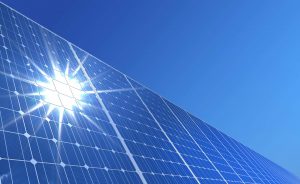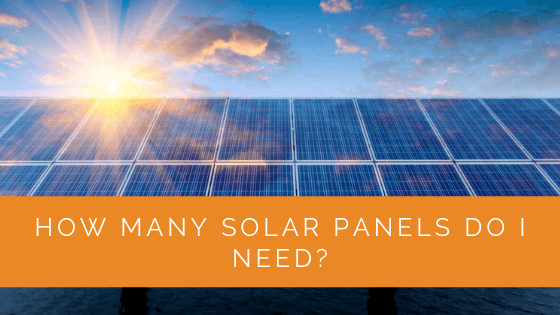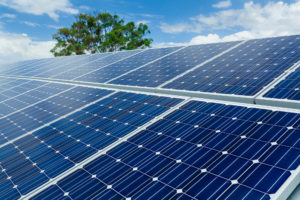Choosing to power your home with the use of solar panels is an excellent option to consider. Not only is it a choice that is good for the amazing planet that we get to call home, but it can also save you a significant amount of your hard-earned cash in the long run.
However, you may be wondering how many solar powers your home needs. The answer to this question lies in understanding several other factors related to the number of panels needed.
For instance, we need to know what other factors influence how many solar panels a home needs and how to calculate the required number. Understanding the amount of roof space required is also an essential factor. Allow us to guide you through the answer to each of these questions.
Contents
- 1 Key Takeaways
- 2 How Many Panels Does The Average Home Need?
- 3 What Things Can Influence How Many Panels I Will Need?
- 4 How Do I Calculate the Number of Panels to Power My Home?
- 5 How Much Roof Space Will I Need?
- 6 Are Solar Panels a Good Fit for My Home?
- 7 What Is the Typical Wattage of A Solar Panel?
- 8 Are There Any Additional Factors that May Influence the Number of Solar Panels Needed Beyond the Ones Mentioned in The Text?
- 9 Case Study: Calculating the Number of Solar Panels for Optimal Home Energy Efficiency
- 10 Expert Insights From Our Solar Panel Installers About Determining the Number of Solar Panels Needed
- 11 Experience Solar Excellence with Us!
- 12 Conclusion
Key Takeaways
- The number of solar panels your home needs depends on factors such as your energy usage, local sunlight, roof direction, shading, and panel wattage.
- To calculate the number of panels needed, first determine your monthly electricity usage in kWh and find the monthly peak sunlight hours for your area. Then, divide the kWh by the monthly sunlight hours to determine the required solar system size in kWh.
- Convert the system size from kilowatts (kW) to watts (W), divide by the solar panel wattage (typically 280W), and you’ll know how many solar panels you need.
- Roof space required typically ranges from 21 to 35 panels, occupying 369 to 598 square feet. Consult a solar installer for a precise assessment based on your home’s specifics.
How Many Panels Does The Average Home Need?
In the US, the average home will need between 21 and 34 solar panels if they are to be used to cover the electrical bill for the running of the house.
Of course, this is quite a wide range so let us now examine the various factors that influence whether your home is closer to the 21 figure or the 34 figure. Interestingly the size of your property is not the only factor at play here.
What Things Can Influence How Many Panels I Will Need?
How Much Energy Your Home Uses
The first critical contributing factor is the amount of energy that your home uses. You may be rambling around in a big house but not use a lot of power, or you could be packed into a small home but have a constant need for a considerable amount of energy.
The best way to get an accurate understanding of how much energy your home needs is to take a look at your monthly kWh on your electric bill. We will discuss this in a little more detail later on.

How Much Sunlight Is in Your Local Area
Another key factor to consider is the amount of sunlight that your home is exposed to daily. Here in the US, homes in a southwest direction tend to get the most sunlight, whilst those facing northeast tend to get the least amount of sunlight.
However, it is important to fully understand the exposure that your own home has, rather than simply relying on this general statement.
The Direction of Your Roof and Shading
The direction of your roof could also impact the number of solar panels required and the system you choose. Also, linked to this is any shading which may shield sunlight that each solar panel is exposed to.
The Panel Wattage That You Plan to Use
The amount of energy that one solar panel produces is dependant on the wattage of the panel. As we will discuss a little later on, most solar panels use one specific wattage.
However, if this is not suitable for your home, a solar panel installer will be able to advise you of other choices which may be more productive.
How Do I Calculate the Number of Panels to Power My Home?
You will be glad to know that when it comes to calculating the number of solar panels that your home needs, a simple and reliable calculation can be used. We will break this down into various steps to make it easier to understand.
Step 1
The first figure that you need is the amount of electricity that your home uses. Take a look at a recent electricity bill and find the figure for kWh of electricity used during the month.
Not all bills are the same. However, most will have this figure at the bottom of the page. You will usually see a small calculation where the amount of electricity used is multiplied by the cost of electricity.
Make a note of this figure. If you think it will provide you with a more accurate calculation, you could also gather several of your most recent electricity bills and take an average for the past few months.

Step 2
The second figure that you need is the amount of sunlight that your home receives. The figure that you want is called peak sunlight hours. It is easy to get this figure mixed up with daylight hours, counted between sunrise and sunset. However, if you use this figure, you will end up with an unreliable result, to say the least.
Peak sunlight hours are the number of hours when the sun’s intensity reaches approximately 1,000 watts per square meter. In other words, during peak sun hours, your solar panels will be the most productive as the sun is at its most powerful during this period of the day.
Of course, if you live in an area where you have a high number of peak sunlight hours, you can expect high productivity from your solar panels.
Unfortunately, if you live in an area where the peak sunlight hours are on the low side of the scale, this will mean your solar panels will have a smaller window each day to produce energy.
This figure also impacts your choice of solar panels. If you live in an area with lots of sunlight and your peak sun hours is a high figure, you will be able to choose a smaller solar panel system and still produce sufficient energy. However, for areas where sunlight is less, a bigger solar panel system will be required.
This figure is one that you will need to find rather than measure for yourself. Usually, a quick online search will provide you with the peak sunlight hours figure for your area.
For instance, in California, the figure is a lovely, high 6.7 hours, while in New Jersey, the peak sunlight hours is low at 4.1 hours.
Step 3
With the above two key figures identified, you are nearly ready to reach an answer. Here is what to do next:
Calculate Peak Sunlight Hours as a Monthly Figure
Multiply the peak sunlight hours figure that you have already identified by 30. Write this figure down as your monthly peak sunlight hours.
Divide Your Monthly kWh by the Monthly Figure
As an example, let’s say that your monthly kWh figure was 1200 kWh, and your above calculated monthly peak sunlight hours was 130. You would divide 1200 by 130, giving you a total of 9.23. Hence you would need a 9.23 kWh solar system to provide enough solar power to cover your electricity bills. A nice easy calculation!
Step 4
Finally, let’s answer the critical questions of how many solar panels would be needed. Here is how to figure it out:
Convert from Kilowatts to Watts
To do this, you need to multiply the solar system size you require for your home by 1,000. Hence our above example of a system that requires 9.23 kWh would give a watts total of 9,230.
Divide the Watts Figure by the Solar Panels Wattage
The typical solar panel will have a wattage of 280. So you need to divide your watt figure by 280, and ‘voila!’ you have your answer.
In our example, we need to divide 9,230 by 280, and our calculation would tell us that 33 solar panels would be needed.
How Much Roof Space Will I Need?
Remember we mentioned at the start that most homes need between 21 and 35 solar panels? This would take up between 369 and 598 square feet of roof space.
For an exact answer, you need to multiply the number of solar panels that are required by 17.55 square feet. That is the area that pretty much all residential solar panels take up.
Are Solar Panels a Good Fit for My Home?
Usually, roof space is not an issue as most homes have sufficient roof space for the number of solar panels that would be needed to power the property. However, other factors such as roof direction and shade may have a more significant impact.
Solar panels may be an ideal choice for your home. However, the best way to understand the pros and cons is to have a qualified solar installer visit your home and carry out an assessment for the best solar panels for you.
This will help you determine how your home’s location would have an impact on running a solar power system for your property.
What Is the Typical Wattage of A Solar Panel?
Most solar panels use one specific wattage, which is typically around 280 watts per panel.
Are There Any Additional Factors that May Influence the Number of Solar Panels Needed Beyond the Ones Mentioned in The Text?
Yes, there are additional factors that may influence the number of solar panels needed. For example, the local climate and weather patterns, the angle of the sun in relation to the roof, the efficiency of the solar panels, and the type of inverter used can all impact the number of panels needed to power a home. It’s always best to consult with a solar installer to get a precise assessment based on your home’s specific needs. energy through customer-centric, tailored solutions. Our articles reflect this commitment, crafted collaboratively by experts to provide accurate, up-to-date insights into solar technology, ensuring our readers are well-informed and empowered in their solar energy decisions.
Case Study: Calculating the Number of Solar Panels for Optimal Home Energy Efficiency
Background
Solar Panels Network USA was approached by a homeowner in California looking to switch to solar energy. The homeowner needed a precise calculation of how many solar panels would be required to meet their monthly energy needs.
Project Overview
The project aimed to determine the exact number of solar panels required to cover the homeowner’s electricity usage, considering factors like energy consumption, peak sunlight hours, roof direction, and shading.
Implementation
- Initial Assessment:
- Energy Consumption Analysis: The homeowner provided recent electricity bills, revealing an average monthly usage of 1200 kWh.
- Sunlight Exposure Evaluation: The location in California was assessed for peak sunlight hours, which averaged 6.7 hours per day.
- Calculations:
- Monthly Sunlight Hours: Calculated by multiplying daily peak sunlight hours (6.7) by 30 days, resulting in 201 peak sunlight hours per month.
- Required System Size: Determined by dividing the monthly kWh (1200) by monthly peak sunlight hours (201), equating to a 5.97 kWh solar system.
- Panel Wattage: Using standard panels with 280 watts each, the system size in watts was converted (5.97 kWh * 1000 = 5970 watts).
- Number of Panels: Dividing the total watts by panel wattage (5970 / 280), it was determined that 22 solar panels would be needed.
- Roof Space and Layout:
- Roof Space Calculation: Each panel required 17.55 square feet, so 22 panels would need approximately 386 square feet of roof space.
- Directional Considerations: The panels were oriented to face south, ensuring maximum sunlight exposure and efficiency.
- Consultation and Installation:
- Professional Assessment: A solar installer visited the home to confirm the calculations, evaluate roof strength, and address potential shading issues.
- Installation: The 22 panels were installed, optimized for maximum efficiency given the roof’s layout and direction.
Results
- Optimal Energy Production: The calculated number of panels met the homeowner’s energy needs, significantly reducing their reliance on grid electricity.
- Cost Savings: The homeowner experienced substantial savings on electricity bills, validating the initial investment in solar panels.
- Environmental Impact: The switch to solar energy contributed to reducing the homeowner’s carbon footprint, aligning with their sustainability goals.
Summary
This case study highlights the importance of thorough calculations and professional assessments in determining the number of solar panels required for a home. By considering energy consumption, peak sunlight hours, and roof conditions, Solar Panels Network USA provided an accurate and effective solution for the homeowner.
Expert Insights From Our Solar Panel Installers About Determining the Number of Solar Panels Needed
The most crucial factor in determining the number of solar panels required for your home is understanding your energy consumption. Reviewing your monthly kWh usage on your electricity bill is the first step in this process.
Senior Solar Technician
Peak sunlight hours vary significantly across different regions. Homes in sunny states like California will require fewer panels compared to those in regions with less sunlight, like New Jersey.
Solar Energy Consultant
Roof direction and shading can greatly impact solar panel efficiency. Ideally, panels should face south and be free from obstructions like trees or neighboring buildings to maximize sunlight exposure.
Renewable Energy Specialist
Experience Solar Excellence with Us!
Trust in Solar Panels Network USA, where our seasoned experts deliver top-quality solar solutions for homes and businesses nationwide. With a legacy of countless successful installations and a commitment to sustainable energy, we’re your reliable partner in the solar journey. Ready for a brighter, eco-friendly future? Call us now at (855) 427-0058 and harness the power of the sun!
Conclusion
It takes a little time to get the information you need to calculate how many solar panels are required for your home. However, it is more than possible to reach an accurate figure yourself.
If it seems like this is a form of energy production that would be a good fit for your home solar panels, it may be time to get in touch with the experts and start to enjoy a lot more benefits from the sun than simply getting a nice tan.
About the Author
Solar Panels Network USA stands at the forefront of solar energy solutions, driven by a team of seasoned solar engineers and energy consultants. With over decades of experience in delivering high-quality solar installations and maintenance, we are committed to promoting sustainable


